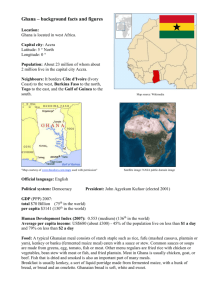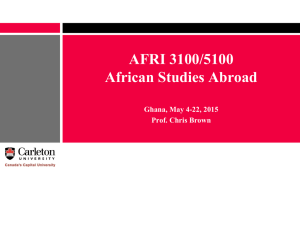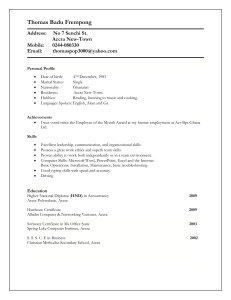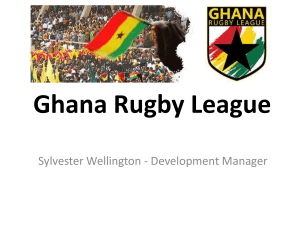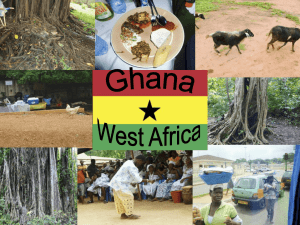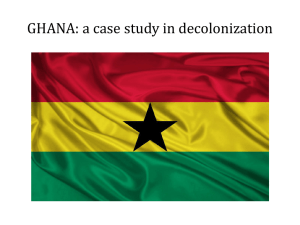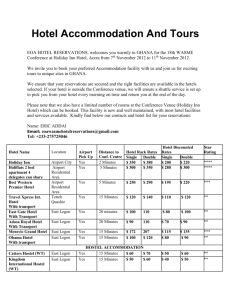GHANA: Slave Coast and Ashanti Kingdom
advertisement
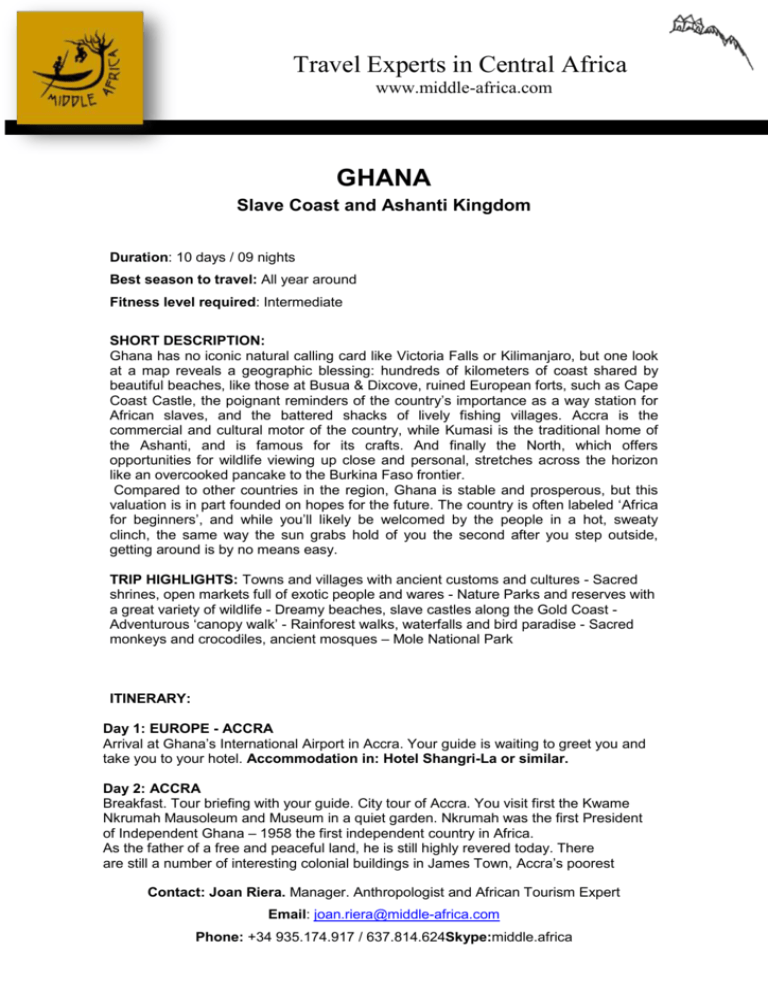
Travel Experts in Central Africa www.middle-africa.com GHANA Slave Coast and Ashanti Kingdom Duration: 10 days / 09 nights Best season to travel: All year around Fitness level required: Intermediate SHORT DESCRIPTION: Ghana has no iconic natural calling card like Victoria Falls or Kilimanjaro, but one look at a map reveals a geographic blessing: hundreds of kilometers of coast shared by beautiful beaches, like those at Busua & Dixcove, ruined European forts, such as Cape Coast Castle, the poignant reminders of the country’s importance as a way station for African slaves, and the battered shacks of lively fishing villages. Accra is the commercial and cultural motor of the country, while Kumasi is the traditional home of the Ashanti, and is famous for its crafts. And finally the North, which offers opportunities for wildlife viewing up close and personal, stretches across the horizon like an overcooked pancake to the Burkina Faso frontier. Compared to other countries in the region, Ghana is stable and prosperous, but this valuation is in part founded on hopes for the future. The country is often labeled ‘Africa for beginners’, and while you’ll likely be welcomed by the people in a hot, sweaty clinch, the same way the sun grabs hold of you the second after you step outside, getting around is by no means easy. TRIP HIGHLIGHTS: Towns and villages with ancient customs and cultures - Sacred shrines, open markets full of exotic people and wares - Nature Parks and reserves with a great variety of wildlife - Dreamy beaches, slave castles along the Gold Coast Adventurous ‘canopy walk’ - Rainforest walks, waterfalls and bird paradise - Sacred monkeys and crocodiles, ancient mosques – Mole National Park ITINERARY: Day 1: EUROPE - ACCRA Arrival at Ghana’s International Airport in Accra. Your guide is waiting to greet you and take you to your hotel. Accommodation in: Hotel Shangri-La or similar. Day 2: ACCRA Breakfast. Tour briefing with your guide. City tour of Accra. You visit first the Kwame Nkrumah Mausoleum and Museum in a quiet garden. Nkrumah was the first President of Independent Ghana – 1958 the first independent country in Africa. As the father of a free and peaceful land, he is still highly revered today. There are still a number of interesting colonial buildings in James Town, Accra’s poorest Contact: Joan Riera. Manager. Anthropologist and African Tourism Expert Email: joan.riera@middle-africa.com Phone: +34 935.174.917 / 637.814.624Skype:middle.africa Travel Experts in Central Africa www.middle-africa.com district, with James Fort, Ussher Fort with Lighthouse and Osu Castle, the seat of the present government. The National Museum has a large collection of archaeological finds from across Africa. Quite a unique experience is a visit to a ‘casket shop’, where coffins in the shape of lions, birds, cars, mobiles or coca cola bottles are being manufactured. Further on your drive through Accra, you see the Independence Square, the presidential palace ‘Jubilee House’ and the Centre for National Culture. The Artist Alliance Art Gallery at La on the coast is a delight of elegant airy rooms full of paintings, tapestries and sculptures by many well known modern Ghanaian artists. Driving along the coast you finally come to the restaurant ‘Next Door’, where you have a ‘welcoming dinner’ with drumming and dancing and music played on ancient instruments in the traditional style. Accommodation in: Hotel Shangri-La or similar. BB Day 3: ACCRA – ADA FOAH (2h) Breakfast. Drive to the Volta Region, Ghana’s most beautiful natural environment. In Ada Foah, the former capital of the Ada Kingdoms, at the mouth of the mighty river Volta, you take a boat to the spot where the river disappears amongst wide stretches of sandbanks into the foaming waves of the Atlantic. Along the easterly riverbanks, you continue your journey to the beaches of the Villa Cisneros Resort where you spend the night. Relax at the palm fringed pool or at the riverside restaurant. The hotel also has a large ostrich farm which you might want to visit. Roasted ostrich is a favourite delicacy! Accommodation in: Villa Cisneros Resort. BB Day 4: ADA AFOH – ATOKOR – HO (3h) Breakfast. The wide expanse of the calming Keta Lagoon with its many waterways and sandbanks offers you one of Ghana’s most important migrant bird sanctuaries. Walking along the beaches you can also observe the daily catch of huge nets full of fish. Visit traditional fishing villages, the Cape St. Paul Lighthouse (the last before Togo) and a small slave market at Atokor which, in vivid wall paintings depicts the exodus and consequent enslavement of the Ewe tribes. Nearby is also the picturesque ruin of Fort Prinzenstein on a pleasant little beach. It has an interesting history which is dramatically told by an enthusiastic local guide. On the way to Ho, in Kente weaving workshops you see the any meter-long looms on which this famous cloth is woven in colourful intricate patterns, to be used mainly for ceremonial costumes. Accommodation in: Chances Hotel, Ho. BB Day 6: WLI FALLS – TAFI ATOME SANCTUARY – KOFORIDUA (4h) Breakfast. The Tafi Atome Monkey Sanctuary can only enchant all animal lovers. These rare monkeys are traditionally seen as sacred and live with the families in the village. They are not shy of humans and a delight to photograph and interact with. Later, you visit the famous Cedi Bead Factory at Krobo Odumase in which the unique craft of moulding glass beads is demonstrated. The small factory shop is well stocked with attractive bead jewellery. On the way to Koforidua, you have the opportunity to learn about the growth of cocoa beans and their processing – one of Ghana’s important exports. Accommodation in: Royal Palace Hotel. BB Day 7: KOFORIDUA – KUMASI (3h) Breakfast. On the long drive to Kumasi, you pass many craft villages, most engaged in traditional wood carvings, such as replicas of the famous ‘Golden Stool’ of the Ashanti Contact: Joan Riera. Manager. Anthropologist and African Tourism Expert Email: joan.riera@middle-africa.com Phone: +34 935.174.917 / 637.814.624Skype:middle.africa Travel Experts in Central Africa www.middle-africa.com Kings. A unique experience is however the Adinkra Symbol Stamping Workshop in Ntonso. Each of the over 60 Adinkra symbols represents an ancient Ashanti proverb. The symbols, carved on wooden blocks are being stamped onto white or red cloth to make ceremonial dresses. You can purchase a symbol and try this art yourself, making a scarf or tie. In Kumasi, Ghana’s second largest city and ancient capital of the Ashanti Kingdoms you may visit the Manhyia Palace (a rather modest building), which is still used by members of the Royal family. The Centre for National Culture in a pleasant garden area, has many attractive galleries and shops exhibiting Ghana’s great variety of arts and crafts. There is also the Prempreh II Jubilee Museum, telling of the dramatic history of the Ashanti Kingdoms. Some friendly restaurants to have lunch. Traditional festivals of the Ashanti people are held here regularly, which show a fantastic mix of colourful people, costumes and performances of traditional music, drumming and dancing. Accommodation in: Sirmax or Miklin Hotel. BB Day 8: KUMASI – ASSIN MANSO – CAPE COAST – ELMINA (4h) Breakfast. You travel south today towards Cape Coast on the Gold Coast. On the way you may visit Assin Manso which is famous for its role in the slave transports in the 18th and 19th centuries. Here, on the romantic banks of the river Ndonkor Nsuo (slave river), thousands of men, women and children, after their long marches through Africa, were given their final bath and checked for fitness before taken to the coast for shipment into slavery. Elmina Castle is one of the most famous of the ‘slave castles’ and the best restored. You not only learn of the long history of the gold trade in the 15th and16th centuries which brought the Portuguese, Dutch, Danish and English to the coast who built many castles as warehouses, but also their use as ‘slave castles.’ You can still see the dungeons and torture instruments used on slaves waiting to be transported. A somewhat happier picture presents itself in the busy fishing harbour of Elmina below the castle. Good opportunity to observe the daily trading in fresh fish – and to photograph. During dinner at the hotel’s beach restaurant, you will again be entertained with African music drumming and dancing. Accommodation in: Coconut Grove Beach Resort. BB Day 9: ELMINA – KAKUM ATIONAL PARK – ACCRA (3h) Breakfast. Before you return to Accra you may enjoy another one of Ghana’s Nature Highlights – Kakum National Park. This dense rainforest invites you on a one hour tour of its rare and ancient trees and plants which are famous for their medicinal values. Then you embark on an adventurous ‘canopy walk’ 40 meters high over 7 rope bridges, to observe Kakum’s wildlife from the tree tops. After arriving in Accra, you will be taken to a day room in a city hotel to refresh and repack before departing to the airport for your return flight home. Day 10: ARRIVAL HOME END OF OUR SERVICES Contact: Joan Riera. Manager. Anthropologist and African Tourism Expert Email: joan.riera@middle-africa.com Phone: +34 935.174.917 / 637.814.624Skype:middle.africa
